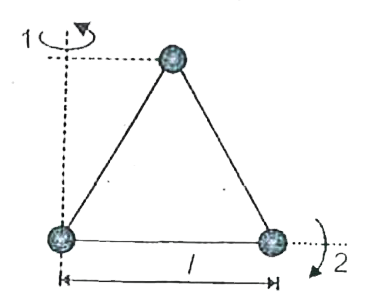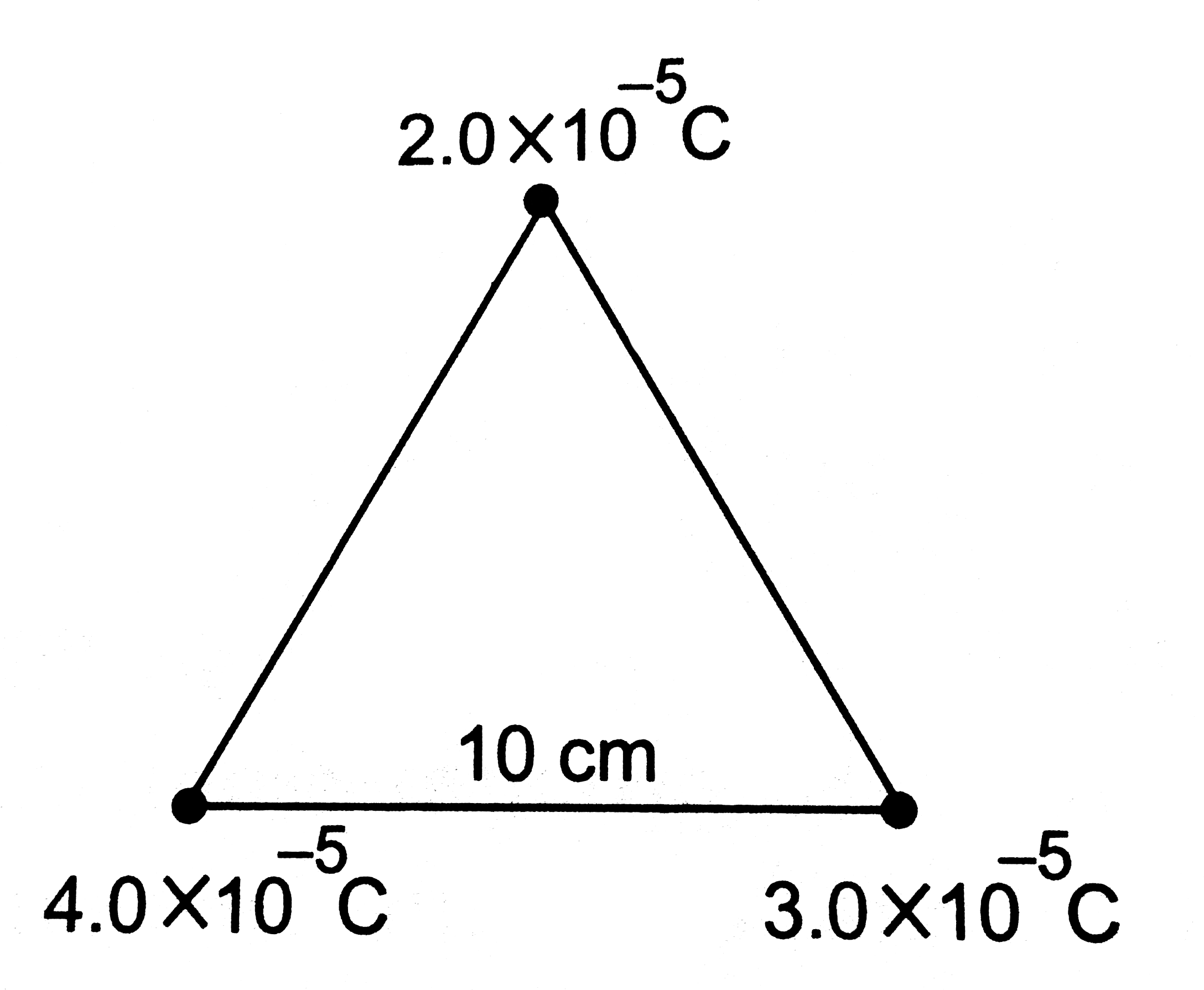Find the work done in brigning three particles each having a mass of 100 g, from large distances to the vertices of an equilateal triangle of side 20 cm.
To find the work done in bringing three particles, each having a mass of 100 g, from large distances to the vertices of an equilateral triangle of side 20 cm, we can follow these steps:
Step 1: Understand the System
We have three particles, each with a mass m=100g=0.1kg. They are to be placed at the vertices of an equilateral triangle with a side length of r=20cm=0.2m.
Step 2: Calculate the Work Done for Each Particle
1. Bringing the First Particle:
- When the first particle is placed at a vertex, there are no other particles exerting gravitational force on it. Thus, the work done U1=0.
2. Bringing the Second Particle:
- The second particle experiences a gravitational attraction from the first particle. The work done U2 to bring the second particle from infinity to the vertex is given by the formula:
U2=−Gm1m2r
where G=6.67×10−11N m2/kg2, m1=m2=0.1kg, and r=0.2m.
3. Bringing the Third Particle:
- The third particle experiences gravitational attraction from both the first and second particles. The work done U3 to bring the third particle is:
U3=−Gm1m3r−Gm2m3r
Since m1=m2=m3=0.1kg, we can simplify this to:
U3=−Gm2r−Gm2r=−2Gm2r
Step 3: Total Work Done
The total work done U in bringing all three particles to the vertices is:
U=U1+U2+U3=0+(−Gm2r)+(−2Gm2r)
U=−3Gm2r
Step 4: Substitute Values
Now, substituting the values:
- G=6.67×10−11N m2/kg2
- m=0.1kg
- r=0.2m
Calculating:
U=−3(6.67×10−11)(0.1)20.2
=−3(6.67×10−11)(0.01)0.2
=−36.67×10−130.2
=−3.335×10−12J
Final Answer
The work done in bringing the three particles to the vertices of the triangle is:
U=−3.335×10−12J
We have three particles, each with a mass m=100g=0.1kg. They are to be placed at the vertices of an equilateral triangle with a side length of r=20cm=0.2m.
1. Bringing the First Particle:
- When the first particle is placed at a vertex, there are no other particles exerting gravitational force on it. Thus, the work done U1=0.
- The second particle experiences a gravitational attraction from the first particle. The work done U2 to bring the second particle from infinity to the vertex is given by the formula:
U2=−Gm1m2r
where G=6.67×10−11N m2/kg2, m1=m2=0.1kg, and r=0.2m.
- The third particle experiences gravitational attraction from both the first and second particles. The work done U3 to bring the third particle is:
U3=−Gm1m3r−Gm2m3r
Since m1=m2=m3=0.1kg, we can simplify this to:
U3=−Gm2r−Gm2r=−2Gm2r
The total work done U in bringing all three particles to the vertices is:
U=U1+U2+U3=0+(−Gm2r)+(−2Gm2r)
U=−3Gm2r
Now, substituting the values:
- G=6.67×10−11N m2/kg2
- m=0.1kg
- r=0.2m
U=−3(6.67×10−11)(0.1)20.2
=−3(6.67×10−11)(0.01)0.2
=−36.67×10−130.2
=−3.335×10−12J
The work done in bringing the three particles to the vertices of the triangle is:
U=−3.335×10−12J
Topper's Solved these Questions
- BOOK - HC VERMA ENGLISHCHAPTER - GRAVITATIONEXERCISE - worked out Examples13videos
GRAVITATION
- BOOK - HC VERMA ENGLISHCHAPTER - GRAVITATIONEXERCISE - Objective -116videos
GRAVITATION
- BOOK - HC VERMA ENGLISHCHAPTER - FRICTIONEXERCISE - Questions for short Answer11videos
FRICTION
- BOOK - HC VERMA ENGLISHCHAPTER - HEAT AND TEMPERATUREEXERCISE - Objective 26videos
HEAT AND TEMPERATURE
Similar Questions
Find the area of an equilateral triangle having each side 4 cm.
View Solutionfind the height of an equlateral triangle having each side 12 cm.
View SolutionCalculate the work required to be done to make an arrangement of three particles each having a charge +q such that the particles lie at the vertices of an equilateral triangle of side a. What work will be doen by electric field when the particles are shifted away so that the side of triangle becomes 2a ?
View SolutionCalculate the amount of work done to dissociate a system of 3 charges 1μC,1μC and 4μC placed on the vertices of an equilateral triangle of sides 10 cm.
View SolutionThe gravitational potential energy of an isolated system of three particles, each of mass m, at the three corners of an equilateral triangle of side l is
View SolutionThree particle each of mass m are placed at the corners of equilateral triangle of side l

Which of the following is/are correct ?View SolutionCalculate the amount of work done to dissociate a system of three charges 1μC,1μCand−4μC placed on vertices of an equilateral triangle of side 10 cm.
View SolutionThe gravitational potential energy of a system of three particles of mass m each kept at the vertices of equilateral triangle of side x will be
View SolutionHow much work has to be done in assembling three charged particles at the vertices of an equilateral triangle as shown in figure
 View Solution
View SolutionThree identical charges, each having a value 1.0×10−8C, are placed at the corners of an equilateral triangle of side 20 cm find the electric field and potential at the centre of the triangle.
View Solution

